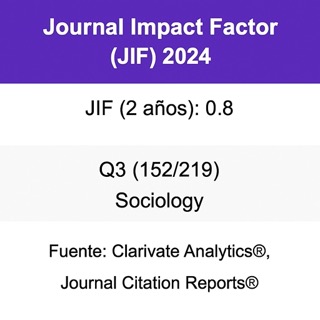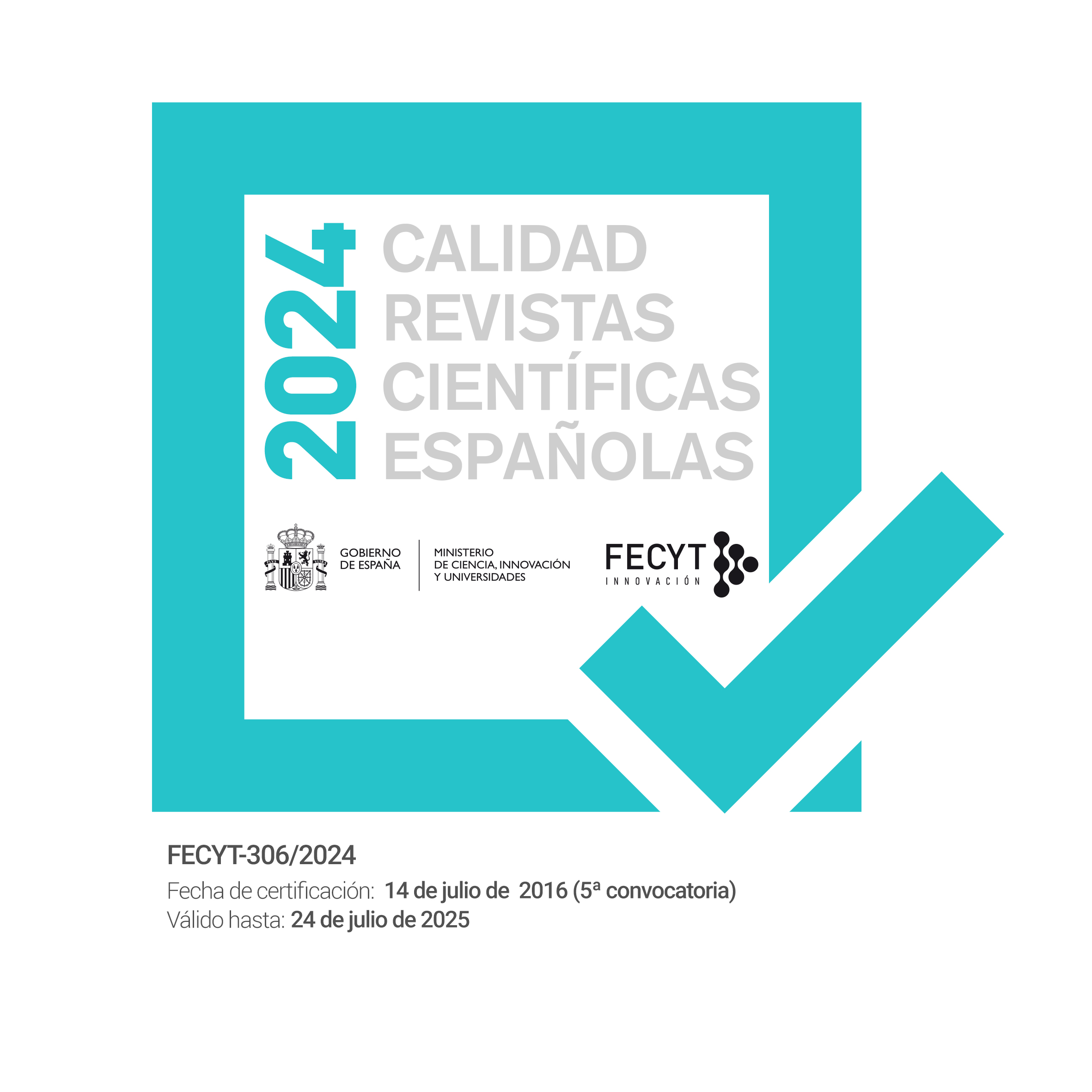Ámbitos emocionales y relacionales de los adolescentes migrantes no acompañados: una aproximación a sus experiencias vividas
DOI:
https://doi.org/10.22325/fes/res.2024.217Palabras clave:
menores migrantes no acompañados, bienestar emocional, bienestar relacional, adolescentes, métodos cualitativosResumen
Desde que las llegadas de menores migrantes no acompañados a España alcanzaran su máximo en 2018, las tendencias han variado en los últimos años, disminuyendo significativamente en 2019 y lentamente empezando a incrementar de nuevo en 2020. Estos adolescentes representan uno de los grupos más vulnerables por sus características especiales estrechamente ligadas a los estresores que encuentran en su proceso migratorio y en la sociedad de acogida. Se ha encontrado que todas estas experiencias afectan a su bienestar; sin embargo, se sabe poco sobre su percepción al respecto, la cual es clave para comprender sus necesidades y perspectivas.
Este artículo persigue indagar en las experiencias vividas por estos adolescentes y cómo este proceso ha afectado a sus esferas relacionales y emocionales, que son clave para su desarrollo en la adolescencia. Estas experiencias se recogieron mediante metodología cualitativa consistente en entrevistas y grupos de discusión realizados en un centro de acogida de menores migrantes no acompañados en Cataluña. La mirada de estos adolescentes se enriquece con contribuciones del personal del centro de acogida. El análisis de los testimonios produjo seis temas principales en torno a expectativas frustradas, obtención de los documentos legales, libertad, contacto con la sociedad española, familia y salud mental. Éstos se discuten considerando cómo afectan al bienestar emocional y relacional en las tres etapas del proceso migratorio.
Citas
Alonso-Fernández, N., Jiménez-García, R., Alonso-Fernández, L., Hernández-Barrera, V., & Palacios-Ceña, D. (2017). Mental Health and Quality of Life Among Spanish-born and Immigrant Children in Years 2006 and 2012. Journal of Pediatric Nursing, 36, 103-110. https://doi.org/10.1016/j.pedn.2017.05.005
Basque Ombudsman. (2021). Protection services for foreign unaccompanied minors in Europe. https://www.theioi.org/ioi-news/current-news/protection-of-unaccompanied-minors-in-europe
Beiser, M., & Wickrama, K. A. S. (2004). Trauma, time and mental health: A study of temporal reintegration and Depressive Disorder among Southeast Asian refugees. Psychological Medicine, 34(5), 899-910. https://doi.org/10.1017/S0033291703001703
Berger, K. S. (2007). Psicología del desarrollo: Infancia y Adolescencia (7th ed.). Panamericana.
Biocchi, L., & Levoy, M. (2008). Los niños indocumentados en Europa: víctimas invisibles de las restricciones a la inmigración. Plataforma para la Cooperación Internacional sobre Migrantes Indocumentados. https://resourcecentre.savethechildren.net/pdf/3785_0.pdf/
Borraccino, A., Charrier, L., Berchialla, P., Lazzeri, G., Vieno, A., Dalmasso, P., & Lemma, P. (2018). Perceived well-being in adolescent immigrants: it matters where they come from. International Journal of Public Health, 63(9), 1037-1045. https://doi.org/10.1007/s00038-018-1165-8
Bravo, A., & Santos-González, I. (2017). Menores extranjeros no acompañados en España: necesidades y modelos de intervención. Psychosocial Intervention, 26(1), 55-62. https://doi.org/10.1016/j.psi.2015.12.001
Caravita, S. C. S., Stefanelli, S., Mazzone, A., Cadei, L., Thornberg, R., & Ambrosini, B. (2020). When the bullied peer is native-born vs. immigrant: A mixed-method study with a sample of native-born and immigrant adolescents. Scandinavian Journal of Psychology, 61(1), 97-107. https://doi.org/10.1111/sjop.12565
Corona Maioli, S., Bhabha, J., Wickramage, K., Wood, L. C. N., Erragne, L., Ortega García, O., Burgess, R., Digidiki, V., Aldridge, R. W., & Devakumar, D. (2021). International migration of unaccompanied minors: trends, health risks, and legal protection. The Lancet Child and Adolescent Health, 5(12), 882-895. https://doi.org/10.1016/S2352-4642(21)00194-2
Council of the European Union. (2004). Common Basic Principles for Immigrant Integration Policy in the EU. https://ec.europa.eu/migrant-integration/librarydoc/common-basic-principles-for-immigrant-integration-policy-in-the-eu
Denzin, N. K., & Lincoln, Y. S. (2008). Strategies of qualitative inquiry. SAGE Publications Inc.
Dodge, R., Daly, A., Huyton, J., & Sanders, L. (2012). The challenge of defining wellbeing. International Journal of Wellbeing, 2(3), 222-235. https://doi.org/10.5502/ijw.v2i3.4
El-Awad, U., Fathi, A., Petermann, F., & Reinelt, T. (2017). Promoting Mental Health in Unaccompanied Refugee Minors: Recommendations for Primary Support Programs. Brain Sciences, 7(12), 1–12. https://doi.org/10.3390/brainsci7110146
Eriksson, M., Wimelius, M. E., & Ghazinour, M. (2019). “I Stand on My Own Two Feet but Need Someone Who Really Cares”: Social Networks and Social Capital among Unaccompanied Minors for Becoming Established in Swedish Society. Journal of Refugee Studies, 32(3), 372-396. https://doi.org/10.1093/jrs/fey030
European Commission. (2005). A Common Agenda for Integration: Framework for the Integration of Third-Country Nationals in the European Union. https://eur-lex.europa.eu/LexUriServ/LexUriServ.do?uri=COM:2005:0389:FIN:EN:PDF
European Migration Network. (2021). Asylum and Migration Glossary 8.0. https://home-affairs.ec.europa.eu/networks/european-migration-network-emn/emn-asylum-and-migration-glossary_en
Fattore, T., Mason, J., & Watson, E. (2012). Locating the child centrally as subject in research: Towards a child interpretation of well-being. Child Indicators Research, 5(3), 423-435. https://doi.org/10.1007/s12187-012-9150-x
James, A., & James, A. L. (2012). Key concepts in childhood studies (2nd edition). SAGE.
Kalverboer, M., Zijlstra, E., Van Os, C., Zevulun, D., Ten Brummelaar, M., & Beltman, D. (2017). Unaccompanied minors in the Netherlands and the care facility in which they flourish best. Child and Family Social Work, 22(2), 587-596. https://doi.org/10.1111/cfs.12272
Karadag, M., & Gokcen, C. (2021). Does Studying with the Local Students Effect Psychological Symptoms in Refugee Adolescents? A Controlled Study. Child and Adolescent Social Work Journal, 38(6), 663–670. https://doi.org/10.1007/s10560-020-00684-2
Karadag, M., & Ogutlu, H. (2020). Prevalence of psychiatric symptoms among refugee adolescents in Turkey: a controlled study. Brazilian Journal of Psychiatry, 43(1), 55–60. https://doi.org/10.1590/1516-4446-2020-0916
López Belmonte, J., López Meneses, E., Vázquez Cano, E., & Fuentes Cabrera, A. (2019). Avanzando hacia la inclusión intercultural: percepciones de los menores extranjeros no acompañados de centros educativos españoles. Revista de Educación Inclusiva, 12(1), 1-20. https://revistaeducacioninclusiva.es/index.php/REI/article/view/482
Manzani, L., & Arnoso Martínez, M. (2014). Bienestar psicosocial en menores y jóvenes extranjeros sin referente familiar adulto: factores de riesgo y protección. Norte de Salud Mental, 12(49), 33-45. https://dialnet.unirioja.es/servlet/articulo?codigo=4830464
Martín-Criado, E. (2005). La construcción de los problemas juveniles. Nómadas, 23, 86-93. http://www.redalyc.org/articulo.oa?id=105116741010
Martínez Rojas, D., Muñoz Henríquez, W., & Mondaca Rojas, C. (2021). Racism, Interculturality, and Public Policies: An Analysis of the Literature on Migration and the School System in Chile, Argentina, and Spain. SAGE Open, 11(1), 1–12. https://doi.org/10.1177/2158244020988526
Mels, C., Derluyn, I., & Broekaert, E. (2008). Social support in unaccompanied asylum-seeking boys: a case study. Child: Care, Health and Development, 34(6), 757-762. https://doi.org/10.1111/j.1365-2214.2008.00883.x
Minkkinen, J. (2013). The structural model of child well-being. Child Indicators Research, 6(3), 547-558. https://doi.org/10.1007/s12187-013-9178-6
National Institutes of Health (NIH). (2018). Emotional Well-Being: Emerging Insights and Questions for Future Research Report of a Roundtable Meeting. In Emotional Well-Being: Emerging Insights and Questions for Future Research.
Neubauer, A. (2021). Debate político en España sobre los menores extranjeros no acompañados en los medios de comunicación digitales. Revista Internacional De Estudios Migratorios, 11(2), 118-145. https://doi.org/10.25115/riem.v11i2.4769
Park, C. L., Kubzansky, L. D., Chafouleas, S. M., Davidson, R. J., Keltner, D., Parsafar, P., Conwell, Y., Martin, M. Y., Hanmer, J., & Wang, K. H. (2023). Emotional Well-Being: What It Is and Why It Matters. Affective Science, 4(1), 10-20. https://doi.org/10.1007/s42761-022-00163-0
Peltonen, K., Qouta, S., El Sarraj, E., & Punamäki, R.-L. (2012). Effectiveness of school-based intervention in enhancing mental health and social functioning among war-affected children. Traumatology, 18(4), 37-46. https://doi.org/10.1177/1534765612437380
Pérez, I. E., Wu, R., Murray, C. B., & Bravo, D. (2021). An interdisciplinary framework examining culture and adaptation in migrant children and adolescents. New Directions for Child and Adolescent Development, 2021(176), 13-39. https://doi.org/10.1002/cad.20405
Plenty, S., & Jonsson, J. O. (2017). Social Exclusion among Peers: The Role of Immigrant Status and Classroom Immigrant Density. Journal of Youth and Adolescence, 46(6), 1275-1288. https://doi.org/10.1007/s10964-016-0564-5
QRS International Pty Ltd. (2020). NVivo 12 Pro (No. 12). https:/7www.qrsinternational.com/nvivo-qualitative-data-analysis-software/home
Radjenovic, A. (2021). Vulnerability of unaccompanied and separated child migrants. In European Parliamentary Research Service (Issue April). http://www.europarl.europa.eu/RegData/etudes/BRIE/2016/595853/EPRS_BRI%282016%29595853_EN.pdf
Raghallaigh, M. N., & Gilligan, R. (2010). Active survival in the lives of unaccompanied minors: Coping strategies, resilience, and the relevance of religion. Child and Family Social Work, 15(2), 226-237. https://doi.org/10.1111/j.1365-2206.2009.00663.x
Salas-Wright, C. P., & Schwartz, S. J. (2019). The Study and Prevention of Alcohol and Other Drug Misuse Among Migrants: Toward a Transnational Theory of Cultural Stress. International Journal of Mental Health and Addiction, 17(2), 346-369. https://doi.org/10.1007/s11469-018-0023-5
Samara, M., El Asam, A., Khadaroo, A., & Hammuda, S. (2020). Examining the psychological well-being of refugee children and the role of friendship and bullying. British Journal of Educational Psychology, 90(2), 301-329. https://doi.org/10.1111/bjep.12282
Senovilla Hernández, D. (2014). Menores no acompañados y no protegidos: resultados de una investigación en cuatro Estados europeos. REMHU : Revista Interdisciplinar Da Mobilidade Humana, 22(42), 81–96. https://doi.org/10.1590/S1980-85852014000100006
Serrano Sanguilinda, I., Fernández García, M., Ordóñez Carabaño, Á., Bajo Marcos, E., & Miguel Somavilla, S. (2019). IMMERSE Common Conceptual Framework. https://doi.org/10.5281/zenodo.10117307
Stefanek, E., Strohmeier, D., Fandrem, H., & Spiel, C. (2012). Depressive symptoms in native and immigrant adolescents: The role of critical life events and daily hassles. Anxiety, Stress and Coping, 25(2), 201-217. https://doi.org/10.1080/10615806.2011.605879
Suárez-Orozco, C., Motti-Stefanidi, F., Marks, A., & Katsiaficas, D. (2018). An integrative risk and resilience model for understanding the adaptation of immigrant-origin children and youth. American Psychologist, 73(6), 781–796. https://doi.org/10.1037/amp0000265
Thommessen, S., Laghi, F., Cerrone, C., Baiocco, R., & Todd, B. K. (2013). Internalizing and externalizing symptoms among unaccompanied refugee and Italian adolescents. Children and Youth Services Review, 35(1), 7-10. https://doi.org/10.1016/j.childyouth.2012.10.007
Tsang, K. L. V., Wong, P. Y. H., & Lo, S. K. (2012). Assessing psycho-social well-being of adolescents: A systematic review of measuring instruments. Child: Care, Health and Development, 38(5), 629-646. https://doi.org/10.1111/j.1365-2214.2011.01355.x
UNHCR. (2005). Report of the fifty-sixth session of the executive committee of the high commissioner’ss programme (Issue October). https://www.unhcr.org/media/report-fifty-sixth-session-executive-committee-high-commissioners-programme-geneva-3-7
UNHCR, UNICEF, & IOM. (2019). Refugee and Migrant Children in Europe. Overview of trends January-December 2018. https://data.unhcr.org/en/documents/details/69499
UNHCR, UNICEF, & IOM. (2020). Refugee and migrant children in Europe: accompanied, unaccompanied and separated. Overview of trends January to December 2019. https://data2.unhcr.org/en/documents/details/87693
UNHCR, UNICEF, & IOM. (2021). Refugee and migrant children in Europe: accompanied, unaccompanied and separated. Overview of trends January to December 2020. https://data2.unhcr.org/en/documents/details/87693
UNHCR, UNICEF, & IOM. (2022). Refugee and migrant children in Europe: accompanied, unaccompanied and separated. Overview of trends January to December 2021. https://data.unhcr.org/en/documents/details/94351
United Nations General Assembly. (1989). Convention on the Rights of the Child. http://www.un.org/documents/ga/res/44/a44r025.htm
Descargas
Publicado
Cómo citar
Número
Sección
Licencia
Derechos de autor 2024 Elena Rodríguez-Ventosa Herrera, Isabel Muñoz San Roque, María Angustias Roldán Franco

Esta obra está bajo una licencia internacional Creative Commons Atribución-NoComercial 4.0.
Todas las publicaciones de la Revista Española de Sociología se realizarán bajo una licencia abierta Creative Commons de Reconocimiento 4.0 Internacional (CC BY 4.0). Dicha licencia establece que los autores son los poseedores de los derechos de propiedad intelectual de sus trabajos, que pueden redistribuirse a cambio de un reconocimiento adecuado. Para más información de la licencia Creative Commons, consultar aquí.
Una vez aceptado un artículo para su publicación, la Revista Española de Sociología solicitará al denominado "autor para la correspondencia" la aceptación de una licencia obligatoria Creative Commons incluida en un acuerdo o contrato de publicación.




